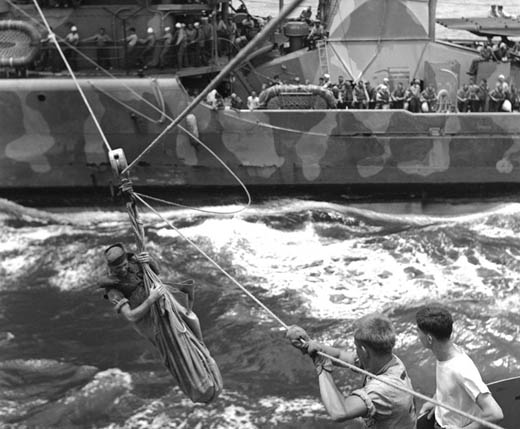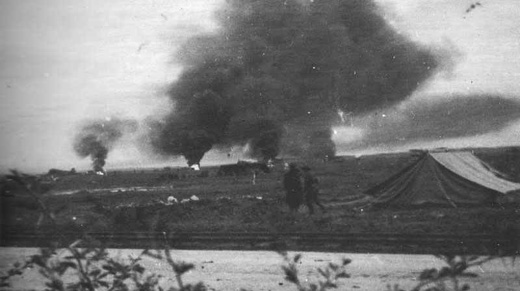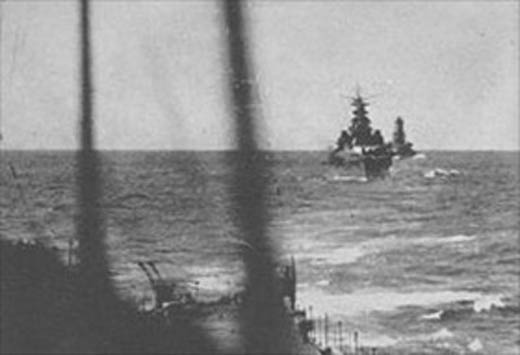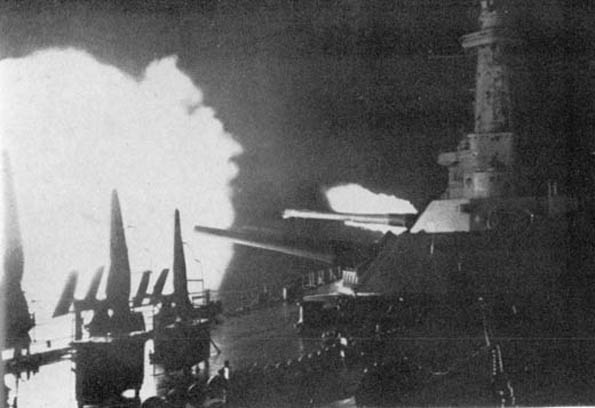Air Operations, Aleutians
1 28th Composite Bomb Group B-24 reconnoitering Kiska and Attu drops bombs on targets of opportunity at both locations.
[Air Operations, Europe
US 8th AIR FORCEFRANCE:
- Unable to locate the La Pallice U-boat base from above because of cloud cover, 15 VIII Bomber Command B-17s and 9 B-24s divert to their secondary target, the St.-Nazaire port area, where they dropped 57 tons of bombs.
- 1 B-24 is damaged.
Air Operations, New Guinea
- 1 V Bomber Command B-25 attacks the track near Soputa.
- 374th Troop Carrier Group transports drop bridging equipment to Australian Army troops at Wairopi.
Air Operations, Solomons
- Cactus Air Force SBDs locate the retiring Japanese Navy bombardment force in New Georgia Sound at 0630 hours, and a strike force composed of SBDs, TBFs, and F4Fs attacks it at 0800 hours. 1 heavy cruiser is severely damaged by bombs and another heavy cruiser is set afire by torpedoes. The Japanese Navy surface force is then tracked by 2 Carrier Air Group 10 SBDs from the USS Enterprise. Upon their departure for Henderson Field, the 2 SBDs attack one of the damaged heavy cruisers, and both score direct hits. Shortly, 2 more Carrier Air Group 10 SBDs attack an undamaged cruiser, but both miss the target. At 1020, a Carrier Air Group 10 strike force composed of 16 SBDs attacks the Japanese force. 1 light cruiser is heavily damaged, 1 heavy cruiser is lightly damaged, and 1 of the previously damaged heavy cruisers is sunk. The SBDs and 2 escorting F4Fs land at Henderson Field.
- 2 V Bomber Command B-17s, based in Australia, locate and attack the Japanese Navy transport force in New Georgia Sound at 0730 hours, and 2 Carrier Air Group 10 SBDs also locate the transports at about 0830 hours. Both SBDs miss targets with their bombs, and one is shot downed by escorting A6M Zeros. Cactus Air Force SBDs and VT-10 TBFs attack the transports at 1100 hours. The SBDs score hits on 3 transports and the TBFs hit 2 transports. 2 transports sink and a third turns back toward the Shortland Islands with 2 escort destroyers. No aircraft are lost. A second attack at 1445 hours by 13 Cactus Air Force and Carrier Air Group 10 SBDs hits 3 transports, of which one sinks outright. Another attack group composed of 8 VS-10 SBDs scores 4 direct hits, and a VS-10 SBD attacking on its own scores yet another direct hit. 15 11th Heavy Bomb Group B-17s attacking in two waves from high altitude between 1500 and 1515 hours score several near misses and apparently down several A6M Zeros. At 1530 hours, 10 Carrier Air Group 10 SBDs launched from the USS Enterprise score 4 hits and a near miss on 5 different transports, of which two sink immediately. An escorting VF-10 F4F downs 1 A6M Zero. In the last attack of the day, mounted at dusk, a mixed group of 14 Marine Corps and Navy SBDs and 4 bomb-laden VT-10 TBFs score 3 direct hits and sink yet another transport, the seventh of the day. Unfortunately, A6M Zero escorts down 3 Carrier Air Group 10 SBDs, and 2 pilots and 2 crewmen are lost.
- Through the day, in numerous engagements between 1100 hours and dusk, Marine Corps F4Fs and SBD gunners claim 21 A6M Zeros and F1M 'Pete' reconnaissance float planes downed over New Georgia Sound, and Carrier Air Group 10 F4Fs and SBD and TBF crews claim 8 Japanese Navy fighters downed over New Georgia Sound.
Eastern Front
Further bitter fighting in Stalingrad after a comparative lull.
On the Caucasian fronts Berlin admits the initiative is in Russian hands.
[Naval Battle of Guadalcanal
Tanaka turns south with his destroyers and transports early on the 14th and immediately comes under heavy air attack. 7 of the transports and 2 warships are lost. The attacking aircraft mostly come from Henderson Field but some are from the carrier Enterprise. Tanaka continues his advance, however, and during the night there is a further battle off Savo Island. The Japanese covering force is now led by Adm Kondo with the battleship Kirishima, 4 cruisers and 9 destroyers. The Americans have brought up TF64 (Adm Lee) with the battleships Washington and South Dakota and 4 destroyers. Shortly before midnight the engagement begins. South Dakota is hit and forced out of the battle but later a devastating 7-minute burst of fire from Washington sinks Kirishima. Control of the seas around Guadalcanal is now passing gradually to the Americans but in this case Tanaka's remaining transports manage to reach Tassafaronga.
Of the troops who have survived the earlier attacks more are killed while landing. After the defeat the Japanese are forced to make considerable use of submarines to transport supplies. Already many of their men are ill and hungry.
|
|
The Japanese continue attempts to neutralize Henderson Field with naval gunfire in preparation for landing reinforcements. An enemy cruiser-destroyer force opens fire early in the morning, but the bombardment is cut short by PT boats. A Japanese troop convoy sails from New Georgia to Guadalcanal. In the convoy are 11 transports and cargo ships and 12 escorting destroyers. The ships carry about 10,000 troops of the 229th and 230th Regiments of 38th Division, artillery men, engineers, replacement units, a naval force of between 1,000 and 3,500 men, weapons and 10,000 tons of supplies. A Southwest Pacific patrol plane spots the convoy at 0830, about 150 miles from Guadalcanal. Guadalcanal aircraft and the Enterprise air group, operating from Henderson Field, get ready to attack with torpedoes, bombs and machine guns. They strike throughout the day. 9 transports are hit, 7 sink while the 4 remaining afloat sail on toward Guadalcanal under cover of darkness. They unload about 4,000 troops and a few tons of supplies. Besides the transports, 1 enemy cruiser is sunk and 3 other warships are damaged.
In another effort to neutralize Henderson Field, the Japanese move a powerful warship force forward, Elements of Adm Kinkaids naval force intercept the enemy warships during the night and in a long-range gun battle sink a destroyer and badly damage the battleship Kirishima, which is scuttled by her crew. US losses in theis engagement are 3 destroyers sunk and 2 other warships damaged.[MORE]
Breeches Buoy Is Put into Service |
 |
Mediterranean
- U-605 is sunk in an air attack by Hudson 'B' of No 233 Squadron off Algiers.
- U-595 is sighted by Hudsons 'C' and 'D' of No 608 Squadron and attacked with depth charges. The charges straddle the U-boat, which dives but resurfaces after a short time. She was so badly damaged she could not dive. The U-boat captain decided to beach her, but was being repeatedly attacked by the aircraft. She was finally beached near Ténès on the Algerian coast. The entire crew is captured by the French.
| Class | Type VIIC |
| CO | Kapitänleutnant Herbert-Viktor Schütze |
| Location | Mediterranean, N of Algiers |
| Cause | Air attack |
| Casualties | 46 |
| Survivors | None |
| Class | Type VIIC |
| CO | Kapitänleutnant Jürgen Quaet-Faslam |
| Location | Mediterranean, W of Oran |
| Cause | Air attack/beaching |
| Casualties | None |
| Survivors | 45 |
New Guinea
The Allies prepare to attack the Japanese beachhead in the area of Buna and Gona. Advance elements of the 126th Infantry, US 32nd Division are consolidating their positions at Natunga, and the Australian 2/6th Independent Company and the 128th Infantry of the US 32nd Division take up positions in the area of Embogu-Embi-Oro Bay. As the 5th Air Force drops bridging equipment, the Australian 25th Brigade puts up a pontoon bridge on the Kokoda track at Wairopi.
[North Africa
ALGERIAThe British occupy Bône harbor. The first tanker arrives on November 17.
Bône Airfield after a Luftwaffe Raid |
 |
The French commander, Gen Barre, begins to move his troops away from the coastal towns in preparation for going over to the Allies.
[Vichy France
Axis fores surround the naval base at Toulon, where the French fleet is concentrated. Despite official denials, they are preparing a military coup.
[
